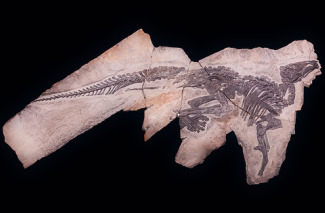A new dinosaur in a prehistoric island in Tethys Ocean

The paleontologist of the Institut Català de Paleontologia Fabio M. Dalla Vecchia has published the study of a new dinosaur from rocks 70 million years old in Italy on the December issue of the Journal of Vertebrate Paleontology. Tethyshadros insularis, this the scientific name of the animal, is the second dinosaur species named from Italy. Complete dinosaur skeletons are extremely rare. The main fossil specimen of the new species, which is known worldwide with the nickname “Antonio”, is extraordinarily complete and articulated. It is the most complete skeleton of a medium-large sized dinosaur ever found in Europe since the discovery of Iguanodon and Dollodon in Belgium (1878) and one of the most complete dinosaurs ever discovered in the world.
It was a plant-eating dinosaur about four meters long belonging to the group of the hadrosauroid dinosaurs. It was more primitive than the famous and characteristic “duck-billed” dinosaurs (Hadrosaurids) of North America and Asia. It shows for the first time the whole and real body morphology of this kind of dinosaur similar but distinct from the “duck-bills”. Tethyshadros lived on a relatively small island in the western part of the ancient Tethys Ocean, between Africa and the North European landmass. At that time Europa was an archipelago of islands at subtropical latitudes. Differently from the new species, most of the known hadrosauroids lived on continents.
Figure 1: Paleogeographic reconstruction of Europe and northern Africa about 70 million years ago (based on Camoin et al., 1993). The red asterisk marks the place of the Adriatic Island of the European Archipelago where Tethyshadros lived. The pink dot and the green cross indicate other European localities where important findings of hadrosauroid dinosaurs have been made, respectively in.
Because an insular dweller, Tethyshadros was rather diminutive for the standard body sizes of its continental “relatives”. North American “duck-billed” dinosaurs were over eight meters long when adults. The insular condition is probably the cause also of the presence of a mixing of primitive, evolute and bizarre features in the new dinosaur, including some suggesting a certain degree of cursorial attitude. Also the peculiar morphology of the tail is possibly related to cursoriality; in the past, this morphology had wrongly led someone to suppose that “Antonio” was a female.
Tethyshadros ancestors reached the European Archipelago migrating from Asia by island hopping. That happened during a moment in Earth history when Tethys Ocean was gradually closing and the Alpine mountain chains were beginning to form because of the northward drift of some southern continents and the incipient colliding of Africa against the Euro-Asiatic continent.
Figure 2: Reconstruction of Tethyshadros (artwork by Lukas Panzarin) based on the holotype (in the background), and the author of the study, Fabio M. Dalla Vecchia, as for scale.
References
"Tethyshadros insularis, a new hadrosauroid dinosaur (Ornithischia) from the Upper Cretaceous of Italy". Dalla Vecchia, F.M. Journal of Vertebrate Paleontology, 29(4) 1100-1116, 2009.


